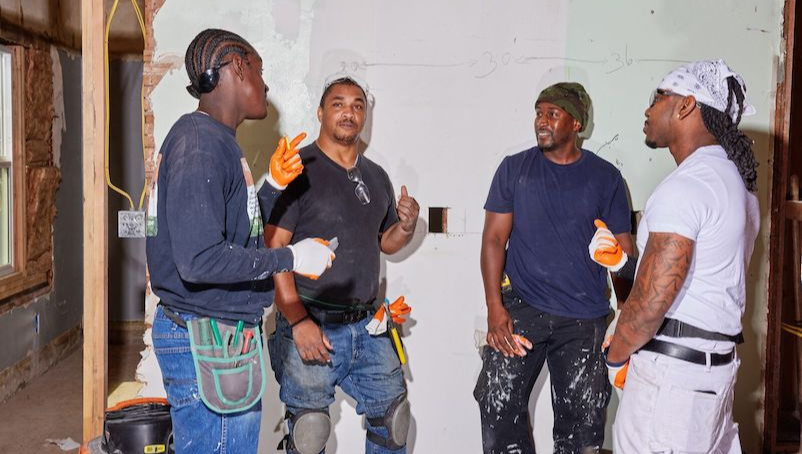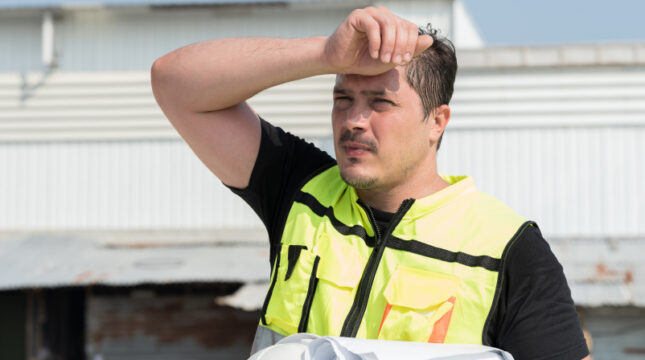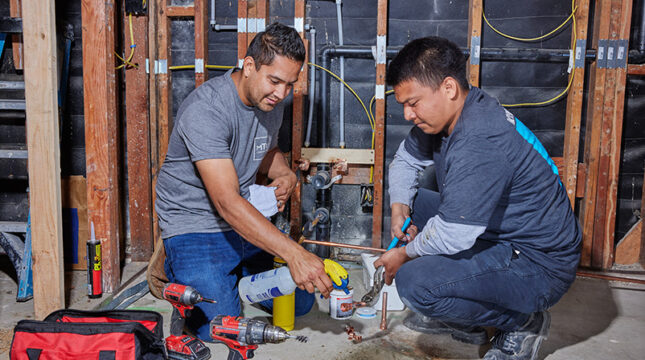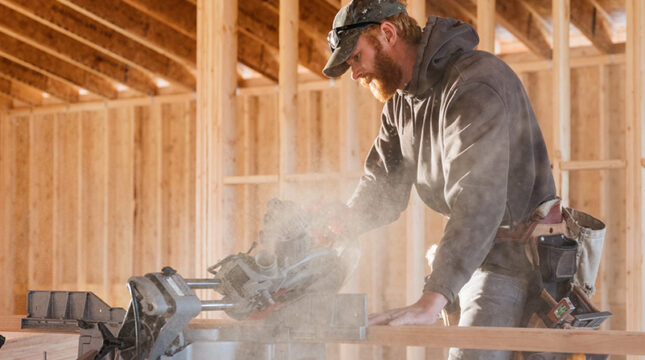1. Ladder safety
Climbing a ladder may seem simple enough, but 81% of falls among construction workers who seek treatment in an emergency room involve a ladder. Therefore, it’s worth reviewing and revisiting this topic periodically.
Ladder safety toolbox talk topics might include:
- Inspecting and maintaining ladders
- Proper ladder selection for different tasks
- Setting up ladders on stable surfaces
- Climbing and descending ladders safely
- Using ladder accessories and fall protection systems
2. Fall protection
According to the Bureau of Labor Statistics (BLS), falls, slips, and trips account for 38.4% of all construction-related fatalities. Proper training is crucial to help prevent these incidents.
Some fall protection training topics:
- Harness and lanyard inspection and usage
- Guardrail systems and their installation
- Safety nets and their proper installation
- Scaffolding and elevated work platform safety
- Training on fall protection equipment and procedures
3. Personal Protective Equipment (PPE)
PPE is essential for safeguarding workers from various safety hazards on construction sites. However, it’s not enough for a business owner to provide PPE; it has to fit properly to be effective. Protective gear is also essential for working during the winter to prevent frostbite.
Toolbox talk topics on PPE:
- Selection and proper use of hard hats
- Eye and face protection guidelines
- Hearing protection and noise exposure awareness
- Hand and foot protection requirements
- Respiratory protection and fit testing procedures
4. Electrical safety
Construction workers are approximately four times more likely to be electrocuted than workers in all other industries combined. While electrocution and electrical burns are significant risks in construction, they are preventable.
Construction meeting topics on electrical safety:
- Lockout/tagout procedures for electrical equipment
- Identifying electrical hazards on the job site
- Safe use of extension cords and power tools
- Working near overhead power lines
- Proper grounding and bonding techniques
5. Excavation and trenching safety
Cave-ins during excavation and trenching operations pose a significant risk to workers. Toolbox talks can address the importance of protective systems, proper training and regular inspections to prevent such accidents.
Excavation and trenching safety topics might include:
- Soil classification and trench stability
- Protective systems for trenching and excavation
- Safe entry and exit procedures for excavations
- Recognizing and addressing cave-in hazards
- Underground utility location and marking
6. Scaffolding safety
Scaffolding is often necessary to get the job done, but it’s also one of the most dangerous locations on a construction site. According to the CDC, approximately 300-400 construction workers are killed each year, most often while working at heights on roofs, ladders and scaffolds. Educating and training workers on scaffolding safety is crucial.
Scaffolding work safety toolbox topics to cover:
- Proper assembly and dismantling of scaffolds
- Inspection and maintenance of scaffold components
- Load capacity and weight distribution on scaffolds
- Fall protection requirements for scaffold work
- Safe access and egress from scaffolds
7. Crane safety
Crane accidents can result in catastrophic consequences. Injuries might include workers being struck by an object or equipment, struck by a falling object put in motion by a crane.
You could cover the following topics during toolbox talks:
- Pre-operational inspections of cranes
- Proper rigging techniques and load calculations
- Crane signals and communication with operators
- Safe operation near power lines and other hazards
- Crane maintenance and repair procedures
8. Fire prevention and safety
Fires on construction sites can cause significant property damage, injuries, and even loss of life. According to the National Fire Protection Association (NFPA), an estimated 4300 fires occur annually in structures under construction, emphasizing the importance of fire prevention and response.
Fire safety training topics include:
- Fire prevention measures on the job site
- Proper storage and handling of flammable materials
- Fire extinguisher types and usage
- Emergency evacuation procedures and assembly points
- Training on fire alarms and emergency communication systems
9. Hand and power tool safety
Hand and power tool incidents account for a significant number of construction-related injuries. Mishandling or neglecting tools such as chainsaws and nail guns might result in severe harm. Safely using hand and power tools has to be a top priority to reduce or eliminate the risk of these injuries.
Tool safety construction meeting topics could include:
- Proper use and maintenance of hand tools
- Guarding and safety features of power tools
- Handling and storing sharp tools safely
- Personal protective equipment for tool use
- Training on specific tool hazards and precautions
10. Confined space entry
Working in confined spaces such as attics, crawl spaces and heating and ventilation ducts poses serious risks. People operating in tight areas are at risk of death from hazardous substances, electrocutions, explosions and asphyxiation.
Toolbox talk topic ideas on confined spaces:
- Identifying confined spaces and their hazards
- Permit-required confined space procedures
- Atmospheric testing and monitoring in confined spaces
- Safe entry and exit procedures for confined spaces
- Emergency rescue and retrieval plans
11. Hot work: Welding and cutting safety
Welding and cutting operations present potential hazards such as burns, fires, eyesight damage due to flashes of light and exposure to toxic fumes. Taking proper precautions can help prevent serious injuries.
Welding and cutting safety issues include:
- Proper ventilation and fume extraction during welding
- Fire prevention measures during welding operations
- Personal protective equipment for welders
- Electrical and shock hazards in welding
- Training on welding techniques and safe practices
12. Ergonomics and lifting techniques
Improper lifting techniques and ergonomics contribute to a significant number of musculoskeletal injuries in construction. According to the BLS, construction laborers experienced 3,950 nonfatal injuries or illnesses due to overexertion in lowering and lifting, resulting in at least one day of work absence.
Consider the following topics in your toolbox talks:
- Proper lifting and carrying techniques
- Using mechanical aids for lifting and moving heavy objects
- Preventing strains and sprains through ergonomics
- Adjusting workstations and tools for optimal ergonomics
- Stretching exercises and warm-up routines
13. Heat stress prevention
It’s not unusual for construction workers to work outdoors during the peak of summer. Working in hot environments can lead to life-threatening, heat-related illnesses. Taking heat stress preventative measures helps keep your employees safe and projects on schedule.
Create toolbox talks on heat safety for the following topics:
- Recognizing the signs and symptoms of heat-related illnesses
- Hydration guidelines and water consumption
- Rest and shade breaks in hot weather
- Personal protective equipment for heat stress prevention
- Training on heat stress prevention and response
14. Hazardous materials handling
Toxic substances like asbestos or lead on construction sites are sometimes invisible to the naked eye. Workers can inhale or accidentally swallow them.
Exposure is more common in enclosed spaces or in close proximity to the substances. Mishandling hazardous materials can lead to toxic dust, chemical exposures, fires and explosions.
Cover these topics in your safety meetings:
- Understanding hazardous material classifications
- Proper storage and labeling of hazardous materials
- Spill response and cleanup procedures
- Personal protective equipment for handling hazardous materials
- Training on specific hazardous materials and their risks
15. Respiratory protection
According to a recent study published in the American Journal of Industrial Medicine, construction workers are much more likely to develop occupational lung illness after exposure to hazardous materials.
Protect your crew with respiratory protection training:
- Selection and fitting of respiratory protection equipment
- Proper maintenance and storage of respirators
- Conducting fit tests and seal checks
- Training on respiratory hazards and protection measures
- Emergency procedures for respiratory incidents
16. Slip and fall prevention
Uneven surfaces, inclement weather and tools on the ground are just a few of the many hazards that lead to slips and falls at a job site. In 2022, one in five workplace deaths occurred in the construction industry, and 38% of these deaths were due to falls, slips, and trips.
Incorporate these slip and fall prevention topics in your toolbox talks:
- Identifying slip and fall hazards
- Safe practices when using stairs on construction sites
- Footwear selection and maintenance
- Strategies for safe walking and working surfaces
- Fall prevention equipment and techniques
17. Housekeeping and cleanliness
Lack of cleanliness and the neglect of worksites can contribute to slips, trips, falls, and other accidents on construction sites. Aside from keeping work spaces safe, clients will appreciate your attention to detail and care in protecting their investment.
Cleaning construction sites meeting subjects include:
- Importance of maintaining a clean and organized work area
- Proper disposal of waste and debris
- Preventing slips, trips, and falls through good housekeeping
- Cleaning and maintaining tools and equipment
- Training on housekeeping standards and expectations
18. Tool and equipment safety
Malfunctioning equipment and improper tool use can lead to injuries on the worksite. Keep tools and equipment functioning properly to keep workers safe.
Tool and equipment toolbox talk topics might include:
- Proper tool selection and inspection
- Proper techniques for carrying, transporting, and storing tools
- Using proper body mechanics and ergonomically designed tools
- Discuss the importance of equipment lockout/tagout procedures
- Tool maintenance and repair
19. Safe handling of heavy equipment
Ensure workers are equipped with the knowledge and skills to operate heavy equipment safely, reducing the risk of accidents, injuries and property damage on construction sites.
Heavy equipment topics to discuss:
- Pre-operational inspections of heavy equipment
- Safe operating practices for heavy equipment
- Traffic management when operating heavy equipment on construction sites
- Regular maintenance and servicing of heavy equipment
- Safe transport and storage of heavy equipment
20. First aid and emergency response
Even when you do everything right, things can go wrong. Workers must know what to do if someone gets injured.
While toolbox talks can’t replace actual first aid training, periodic reminders include:
- Basic first aid techniques
- Identifying and responding to common workplace injuries
- Emergency response and evacuation plans
- Reporting incidents and seeking medical assistance
- Training on emergency equipment and procedures
Construction safety meeting tips
When holding a toolbox talk, you want what you say to resonate with workers. Here are some tips to keep your presentation interesting, your employees engaged and your message memorable.
- Review the information before the meeting. If you stumble through your words, pause frequently or roll through your message so quickly that no one can keep up, you’ll lose your workers’ attention. Take a few minutes to practice what you’ll say before the meeting.
- Keep it short. Your workers show up ready to get started every day. They don’t want to listen to you drone on endlessly. Keep the meeting short and to the point so they don’t tune you out.
- Choose a distraction-free work environment. It’s hard to focus when surrounded by a whirlwind of activity.
- Use props. Ladders, fire extinguishers and power tools all make great props and can help drive your point home. Choose materials that relate to the topic you’re discussing.
- Use humor. Toolbox talks don’t have to be boring. You can have a sense of humor and make your point at the same time.
- Be careful when using examples. Examples make it more likely that people will remember what you discuss. However, you need to be cautious when choosing what stories to tell. Don’t include examples that involve a worker on the current job.
- Invite questions. When you’re finished with your presentation, take time for questions to make sure everyone understands what you discussed. Don’t put anyone down for asking a question.






